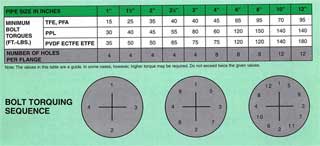INSTALLATION AND MAINTENANCE INFORMATION FOR FUSIBOND PLASTIC
LINED PIPE AND PLASTIC LINED FITTINGS
The same installation procedures for conventional flanged steel pipe and fittings
can be used to install any of FUSIBOND'S PLASTIC LINED PIPING SYSTEMS.
Pipe hangers, supports, anchors, guides and expansion joints or
loops should be in compliance with accepted piping practices.
End covers should not be removed until plastic lined pipe is
ready to be bolted into position or sealing faces may become damaged
or distorted. If covers are removed for inspection, they should
be replaced as soon thereafter as possible. NEVER use heat or
a chisel to remove bolts as the plastic face may be damaged.
Gaskets are not required with FUSIBOND PLASTIC LINED PIPING
except when connected to a flanged face of unlined material. Gaskets
of the elastomeric type are usually most suitable and should always
be approximately the same ID as the lined pipe.
Bolts should be tightened using the following torques as a guide. Use the criss-cross method shown; NEVER clock or counter-clockwise. Installation in cold weather may require considerably higher bolt torques.

Click image for larger view
FLARELOCK joints are recommended where high pressure or temperatures are encountered. Cycling temperatures or long runs can also result in higher plastic face loads. FUSIBOND'S FLARELOCK can be used to eliminate joint creep or cold flow, especially with PTFE Lined Systems.
When assembling FUSIBOND PLASTIC LINED PIPING, always use new
nuts and bolts. Threads must be cleaned and lubricated and washers
are suggested under the turned element, (head or nut) Using a
torque wrench, cross torque the nuts to one-half (1/2) the value
shown in the table following the sequence shown above. Check carefully
to make sure the plastic faces are exactly parallel, then torque
to the final value, again following the above sequence.
If a flange leak occurs and the bolts on the leaking side are properly torqued, DO NOT TIGHTEN FURTHER or permanent damage to the sealing face may result. The bolts on the opposite side should be loosened a quarter turn at a time and then the bolts on the leaking side should be tightened by the same amount. If the leak persists, the bolts should be removed and the plastic sealing faces examined for scratches or dents across the entire face which could provide a leak path. Any scratches or dents which do not exceed 10% of the liner thickness can be eliminated by hand polishing with fine abrasive emery cloth or filed with a flat, wide, fine tooth file. Larger depressions maybe covered using an appropriate gasket.
If leakage occurs after the system has been cycled to elevated temperatures and back to ambient, bolts should be retorqued after the cool down period. No further tightening should be necessary.
NO WELDING OR FLAME CUTTING should be done close to the metal
plastic lined pipe or plastic lined fittings unless adequate precautions
are taken to prevent their being exposed to excessive heat.
Vent holes should not be plugged with paint, cement, etc. The
vent holes are necessary only with PTFE/PFA to release gases which
may be generated at elevated temperatures and become trapped between
the plastic liner and housing. If not vented, these gases may
collapse the plastic liner. Vent holes are placed under the flanges
for safety. This is essential when flange covers are used with
hazardous materials.
Smooth shims 1/32" to 1/16" thick, can be used to facilitate sliding the pipe or fittings into position when making final connections or installing individual sections in an existing line.
To preserve the plastic sealing faces and protect them from
damage while not in use, end covers or blind flanges should always
be installed immediately on all plastic lined piping items which
are removed from service.
If you require more specific inforrnation about the installation
of our plastic lined piping systems, please feel free to contact
us.

![]()



